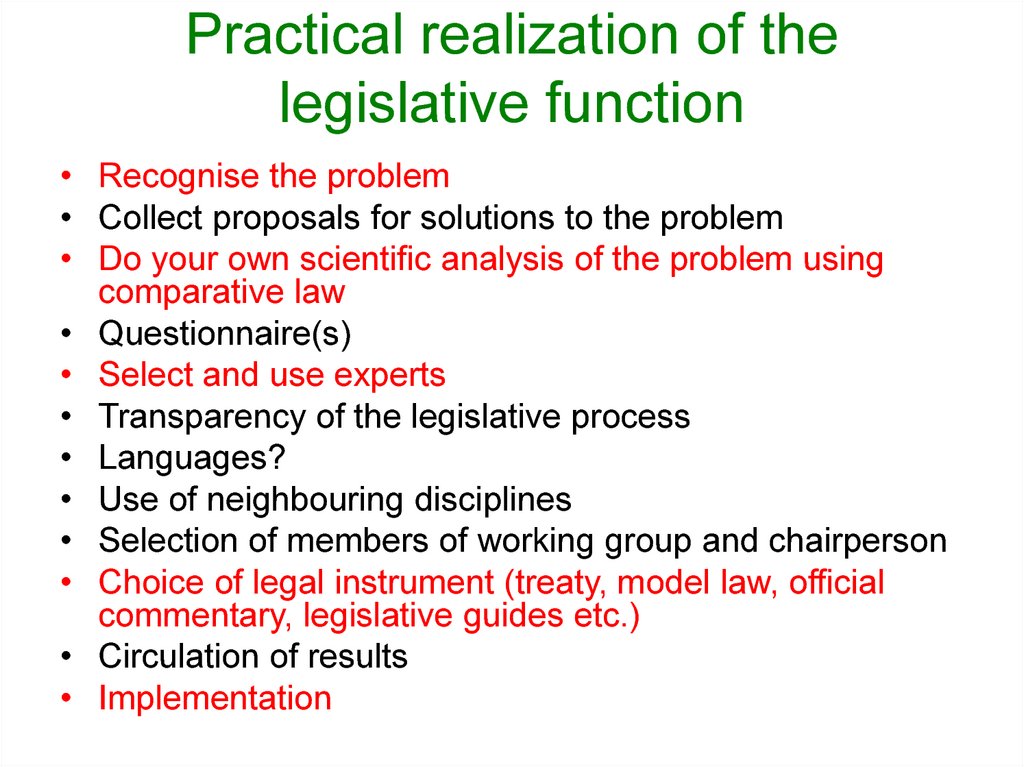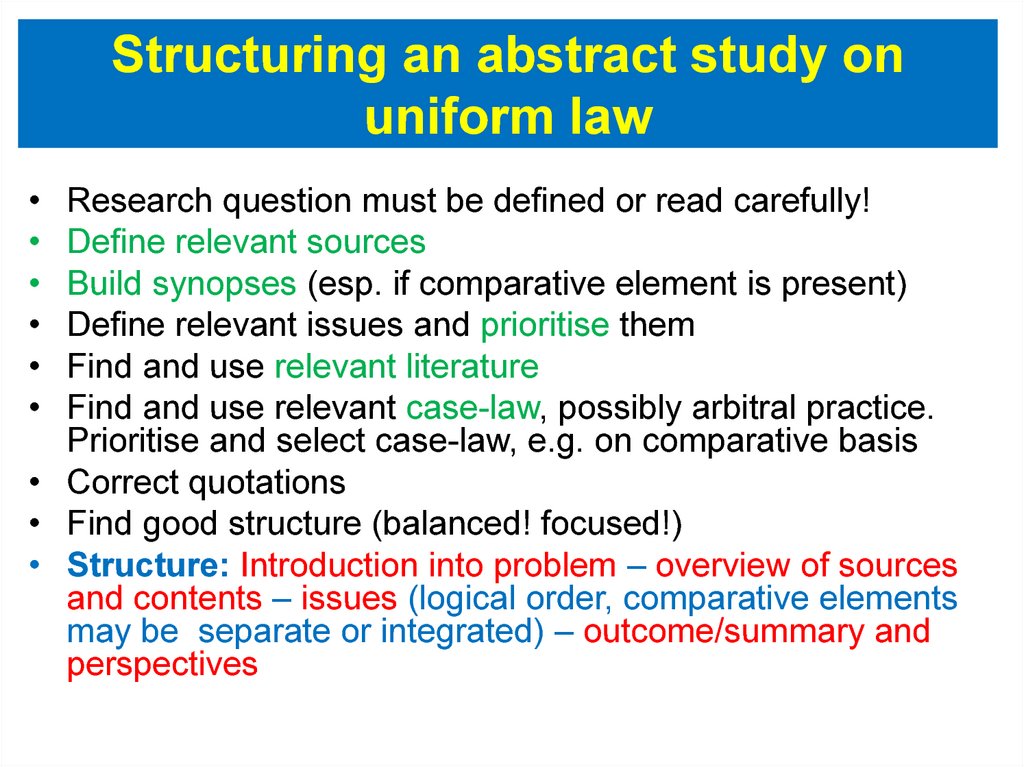Похожие презентации:
Unification of Law and Uniform law – an Introduction
1. Prof. Dr. Alexander Trunk Institute of East European Law Kiel University, Germany Unification of Law and Uniform law – an
IntroductionLecture at Irkutsk State University
18 September 2018
2. What is „uniform law“? What means „unification of law?
3.
Notion, purpose and object ofunification of law and uniform law
• Starting point: Divergence of national legal orders
• Possible conclusion: wish for national/international
unification of law (not only reception of foreign law):
process and result of unification of law(s)
• Process: Unification of law
(harmonization/approximation of law/s)
• Result: Uniform law
• Object: all legal areas. Particularly important in
international business law
4.
United Nations – 193 member states5.
Practical example on uniform law• You are the head of the legal department of a
Russian enterprise, which intends to buy
computers from a Chinese enterprise. The
CEOs of both enterprises have in principle
agreed on the purchase. You are asked to
negotiate the detailed contract with your
Chinese counterpart.
• Does this case raise issues of uniform law?
6.
Approach to answers• Substantive sales law
- CISG
- UNIDROIT Principles of International
Commercial Contracts
- INCOTERMS
• Conflict of laws: Minsk Judicial Asssistance
Convention of 1993?
• Dispute settlement
- Russia China Judicial Assistance Treaty of 1992
- UNCITRAL Model Law on International
Commercial Arbitration 1985/2006
7.
Structure of the subject„Uniform Law“
• General part: functions, institutions, history,
information, methods
• Special part: uniform law in different
subject areas
• cross-border and/or domestic matters only:
„transnational law“. For example international
business transactions
• universal or regional approaches
8.
Functions of uniform law• Legislative function: practical realisation of
„best practices“ or „minimum standards“?
Searching for common denominator – „new“
solutions?
• Forensic-practical function: correct application
of uniform law
• Scientific function: search for „best solution“ or
acceptable compromise. General part – specific
part
9.
10.
Neighbouring disciplinesLegal history
Comparative law
Sociology of law
Economic analysis of law
Private international law (PIL, conflict of
laws)
11.
Historical sketchAncient Greece: Aristotle, Platon
Roman law
Middle Ages: canon law (kanonisches Recht)
Formation of states in modern times
Unification of law as a scientific discipline and
by specialized international organizations
since the end of the 19th century
• General upswing since mid 20th century
(UN-suborganizations, EEC/EU)
12.
Literature and jurisprudence• Monographs, e.g. Andenas/Andersen, Theory and Practice
of Harmonization (2012), Bachin, Subpravo (2002),
Kropholler, Internationales EinheitsR (1975), Marquis,
International Uniform Commercial Law: Towards A
Progressive Consciousness (2005)
• Series of publications + Casebooks
• Law journals, eg Uniform Law Review (available at Unidroit
website)
• Specialised international case law databases such as
CLOUT, Unilex, national databases
• Electronic databases and Internet, eg LexisNexis, Westlaw,
HeinOnline
13.
14.
15.
16.
Institutions of unification of law• International organizations
- Universal: UN and suborganisations (e.g.
UNCITRAL, UNCTAD, IMO, UNECE), UNIDROIT,
OECD, Hague Conference on Private International
Law …
- Regional: Council of Europe, EU, Nordic Council,
Council of Baltic Sea States, CIS/Eurasian Economic
Union, ASEAN, OAS, OIC, African Union …
• Private institutions („NGOs“)
- Business: International Chamber of Commerce (ICC)
- Science: International Law Association, Institut de
droit international
17.
18.
19.
20.
established 196921.
Sources of uniform law• Distinguish: Binding legal norms – non-binding
rules (soft law)
• International treaties – supranational law – model
laws – quasinormative rules (eg Unidroit Principles
of International Commercial Contracts) – general
principles of law
• Legislative guides – autonomous unification of law
• Trade customs – general contract terms: Incoterms
etc.)
• Case law
22.
Presently 89 ratifications23.
24.
25.
Methods in the field ofunification of law/uniform law
• Legislator: Issues of legislative
technique
• Practitioner: Interpretation
• Scholar: Structuring an analysis
26. Legislative technique: Practical task
You work in the UNCITRAL secretariat. Ata working session the representatives of
three States suggest that UNCITRAL
should update the CISG. You are asked to
develop a concept.
How would you proceed?
27.
Practical realization of thelegislative function
• Recognise the problem
• Collect proposals for solutions to the problem
• Do your own scientific analysis of the problem using
comparative law
• Questionnaire(s)
• Select and use experts
• Transparency of the legislative process
• Languages?
• Use of neighbouring disciplines
• Selection of members of working group and chairperson
• Choice of legal instrument (treaty, model law, official
commentary, legislative guides etc.)
• Circulation of results
• Implementation
28.
Interpretation of uniform law• Principles of interpretation. Language issues.
Relationship between different instruments?
• „Model character“ of a specific legal order?
• Uniform interpretation? Informal approach institutional approaches: specialized courts or
court cooperation.
• Autonomous interpretation?
• Approaches to gap-filling
• Support tools for interpretation: international
level – national level
29.
30.
Structuring an abstract study onuniform law
Research question must be defined or read carefully!
Define relevant sources
Build synopses (esp. if comparative element is present)
Define relevant issues and prioritise them
Find and use relevant literature
Find and use relevant case-law, possibly arbitral practice.
Prioritise and select case-law, e.g. on comparative basis
• Correct quotations
• Find good structure (balanced! focused!)
• Structure: Introduction into problem – overview of sources
and contents – issues (logical order, comparative elements
may be separate or integrated) – outcome/summary and
perspectives
31.
Compare structure of PECP with German Civil CodePrinciples of European Civil
Procedure
Art.1. Conciliation
Art.2 Commencement of the
Proceeding
Art.3 Subject Matter of Litigation
Art.4 Discovery
Art.5 Evidence
Art.6 Technology and Proof
Art.7 Discontinuance
Art.8 Default
Art.9 Costs
Art.10 Provisional Remedies
Art.11 Order for Payment
(Mahnverfahren)
Art.12 Enforcement of decisions for
payment
Art.13 Astreinte
Art.14 General provisions: timelimits etc.
German Code of Civil Procedure
Book 1 General regulations
Chapter 1 Courts
Title 1 Substantive jurisdiction of the courts; regulations as to value, §§ 1 – 11
Title 2 Venue, §§ 12 – 37
Title 3 Agreement as to the jurisdiction of the courts, § 38 - 40
Title 4 Disqualification and recusal of court personnel, § 41 –
Chapter 2 Parties, §§ 50 –
Title 1 – 2 …
Title 3 Involvement of third parties in the legal dispute
Title 4 Attorneys of record and counsel
Title 5 Costs of the proceedings
Title 6 Provision of security
Chapter 3 Proceedings
Title 1 Hearing for oral argument, §§ 128 –
Title 2 Procedure for the Service of Records or Documents, §§ 166 –
Title 3 Summonses, hearings, and periods
Title 4 Consequences of failure to take action; instruction on available legal
remedies; restoration of the status quo ante
Title 5 Interruption and suspension of the proceedings
Book 2: Procedural rules for proceedings before the courts of first instance
(regional courts/Landgerichte – local courts/Amtsgerichte)
Title 1 Proceedings until a judgment is entered, §§ 253 –
Title 2 Judgment, §§ 300 –
Titel 3 Default judgment, §§ 330 Title 5 General regulations on taking evidence, §§ 355 –
Book 3 Appellate remedies, §§ 511 –
Book 7 Summary proceedings for a payment order
Book 8 Compulsory enforcement
Book 10 Arbitration proceedings, §§ 1025 –
Book 11 Judicial collaboration within the European Union, §§ 1067 - 1109
32.
Solving a case under uniform lawFind relevant legal instrument(s)
Instrument in force?
Instrument applicable?
Logical structure. Basis for claim as typical
starter. Then solving case as usual.
• Specifics:
• Comparative elements may have to be included
• Often conflict of laws issues arise
• Other legal instrument or national law may have to
be applied additionally
• Determine summary or outlook
33. Practical case (example)
Seller A from Germany sells to buyer B inVietnam some goods. Buyer does not pay,
says goods are defective. What can A do?
34.
35.
Structure of the CISG• Part I: Sphere of Application and General
Provisions (Art. 1–13)
• Part II: Formation of the Contract (Art. 14–24)
• Part III: Sale of Goods (Art. 25–88): General
provisions – obligations of seller (+ rights of buyer)
– obligations of buyer (+ rights of seller) – passing
of risk – provisions common to seller and buyer (eg
damages)
• Part IV: Final Provisions (Art. 89–101)
36.
Typical issues• Applicability of the CISG: in particular Art.1 - 3
• Relation between the CISG and national law;
the problem of external and internal gaps: Art.7 II
• The form of the contract: Art.11
• Offer and acceptance: Art.14 et seq.
• The interpretation of the contract: Art.8?
• Specific performance: Art.28
• The concept of (fundamental) breach of
contract: Art.25
• Damages: Art.74 et seq.
37. Start: Legal basis for claim(s)
CHAPTER III. OBLIGATIONS OF THE BUYERArticle 53
The buyer must pay the price for the goods and
take delivery of them as required by the contract
and this Convention.
38.
Analysis of court/arbitrationdecisions on uniform law
• International or European case law
Please give an analysis of the judgment of the European
Court of Justice of …
• National case law on uniform law (eg CISG)
problem
Please give an analysis of the judgment of the German
Supreme Court of 28 May 2014, VIII ZR 410/12
http://cisgw3.law.pace.edu/cases/140528g1.html)
• Case law on uniform law (or different uniform
laws) in comparison
Please compare the judgment of the German Supreme Court
of … with the judgment of the US Supreme Court of …, A. v.
B. (554 U.S. 222 (2008).
39. United States District Court, Southern District of New York Cedar Petrochemicals, Inc., Plaintiff, v. Dongbu Hannong Chemical
Co., Ltd., DefendantNo. 06 Civ. 03972(AJN), October 21, 2013
OPINION
Plaintiff Cedar Petrochemicals, Inc. ("Cedar"), brought this breach of contract action against
Defendant Dongbu Hannong Chemical Co., Ltd. ("Dongbu"), alleging that Dongbu had delivered
non-conforming liquid phenol, in violation of the parties' written and oral contracts and in
contravention of its obligations under the Convention on Contracts for the International Sale of
Goods, Apr. 11, 1980 …. A nonjury trial was held in this action on September 30, October 1, and
October 2, 2013.
In short, the parties' dispute relates to a 2005 maritime shipment of the liquid petrochemical phenol. The phenol at
issue ("the Phenol") was transported from its on-shore storage tank in Yuso, Korea, to Defendant's ship, the
Green Pioneer, which carried it to Ulsan Anchorage, Korea. Once there, the Phenol was transferred from the
Green Pioneer to Plaintiff's ship, the Bow Flora, which carried it to port at Rotterdam, The Netherlands. On arrival
at Rotterdam, it was determined that the Phenol was damaged. .. in order to demonstrate liability, Plaintiff must
prove by a preponderance of the evidence that the Phenol was injured before it passed the rail of the Bow Flora.
… On this factual point, the Court was unpersuaded. …
I. FINDINGS OF FACT
A. The Parties and Jurisdiction …
III. CONCLUSION: Based on the above-mentioned findings of facts and conclusions of law, the
Court concludes that Plaintiff has not shown by a preponderance of the evidence that the Phenol at
issue was injured prior to crossing the rail of the Bow Flora. Having failed to make this showing,
Plaintiff cannot establish that Defendant breached the parties' agreement. Accordingly, judgment is
granted in favor of Defendant.
40. Case law analysis, e.g. international courts, national courts, several courts in comparison
Introduction - The problemThe facts (short + relevant, in your own words)
The decision: contents, structure, procedure (e.g. preceding
decisions), argumentation. In case of the Court of Justice
of the EU: see also opinions of Advocates General
The issues in context of the relevant legal norms and other
jurisprudence. Make good structure + prioritise! Is already
commentary available? Correct quotations! Has relevant legal
instrument changed or is change planned?
Critique?
Possibly comparison
Conclusions, e.g. evaluation of the decisions, legislative
proposals.Think beyond the decision!









































 Право
Право








